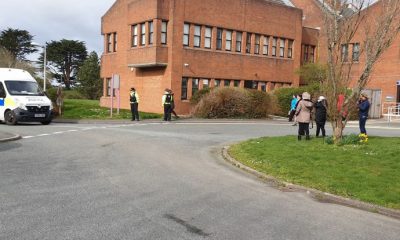Farming
The badger vaccination programme: Is it working?

Caught in a trap: An illegally snared badger
THE WELSH GOVERNMENT issued a press release last week hailing its success in delivering 5,000 vaccinations against Bovine TB (bTB) in the Intensive Action Area against the disease in North Pembrokeshire, South Ceredigion, and North-West Carmarthenshire.
The press release read: ‘More than 5,000 doses of badger vaccination have been administered to animals inside the Intensive Action Area (IAA) in West Wales over the past four years. We are now half way through the fourth year of the Welsh Government’s five-year badger vaccination project in parts of Pembrokeshire, Carmarthenshire and Ceredigion, which forms part of a wider programme of work to eradicate TB from cattle in Wales.
‘The Deputy Minister for Farming and Food, Rebecca Evans, said: “Since 2010 we have introduced a number of additional measures in the IAA because it was identified as having some of the highest rates of incidence of TB in Europe.
“We are now half way through 2015’s round of the vaccination project and provisional results indicate we have successfully delivered over 5,000 doses of the vaccine in the IAA across the four years”.’
The statistics accompanying the summary were released at the same time.
The Herald delved into the data to establish what it told us about bTB rates and the effectiveness of the vaccination programme.
The history of bTB control
It is 55 years since the whole of the UK became attested on October 1, 1960. Each cattle herd was certified as being subject to regular tuberculin testing with immediate slaughter of any reactors. Progress was maintained throughout the 1960s and 1970s.
The ‘clean ring strategy’ was a badger culling strategy introduced in 1982. It involved cage trapping badgers on land occupied by affected cattle herds, then on adjoining land, expanding outwards until no further infected animals were captured. It was abandoned in 1986 as being non cost-effective.
Between 1986 and 1997, the UK Government pursued a strategy in which badgers were cage-trapped and shot. However, the strategy was only piecemeal, largely because of pressure from animal charities and single-issue pressure groups that meant that only badgers on land occupied by the affected herd would be culled.
Bearing in mind current claims that culling badgers is ineffective because of the proposition that badgers would simply leave the culling area to go to a neighbouring area, the methodology adopted between 1986 and 1997 in order to prevent wider scale slaughter of badgers appears both flawed and naïve: a strategy doomed to fail, and predictably so.
Culling in other countries
In New Zealand the success of culling the principal vector for the disease, the possum, has been markedly successful.
In 1990 the proportion of TB in cattle was about 7 times greater than it was in Great Britain. However in 1997 the proportions were about equal. By 2011, the proportion in New Zealand is about 40 times less than what it is in Great Britain.
Since the early nineties, control of the principal wildlife vector, the possum has increased whilst in Great Britain since 1986 control of the principal wildlife vector, the badger, has reduced.
The method of culling in Ireland relies on the use of snares and the subsequent shooting of trapped badgers. That method, widely condemned as cruel, is expressly forbidden in the UK. The effectiveness of the range of bTB measures – including culling – adopted in Ireland has driven rates of bTB infection in herds to their lowest ever level.
Bovine TB figures have, however, also fallen in Northern Ireland, were no licensed culling has taken place. That fact has been alighted upon by those opposed to a cull as evidence of the ineffectiveness of shooting badgers in order to control bTB. However, bTB rates are still substantially higher in Northern Ireland than in the Republic of Ireland: in 2013 6.4 per cent of cattle herds tested positive in Northern Ireland compared to 3.8 per cent south of the border.
As might be ruefully observed, the validity of statistical evidence and the science deployed by those on either side of the culling debate is likely to remain subjective and views remain entrenched. Wildlife and animal charities will continue to deride culling, while those who deal with the personal and economic fallout of bTB will favour it.
The Welsh decision
It was against the background of apparent comparative success of culling in other countries that the Welsh Government decided to begin a five year vaccination trial in West Wales and worth recalling that the Welsh Government embarked upon a vaccination programme as very much a second preference.
In 2012, Welsh Labour abandoned a previous policy, formed in coalition with Plaid Cymru, which supported a badger cull and decided to pursue a policy of vaccination. In doing so, it was criticised by the then Chair of the British Veterinary Association for ignoring scientific evidence supporting a cull and accused of ‘cowardice’ in the face of a celebrity-backed campaign against the cull and pressure from animal charities.
The decision not to proceed was described as a betrayal of farmers whose herds remain affected by the reservoir of bTB in the wild badger population.
But what, it is fair to ask, is the Welsh Government’s ‘Plan B’?
What if the data suggests that vaccination is no more effective than doing nothing?
A farmer’s experience
The Herald spoke to one farmer, who provided his observations on life in the IAA on condition of strict anonymity.
The farmer told us: “My dairy herd has suffered from bTB for 12 years. In 2012, badgers began to be vaccinated in the area, along with strict cattle control.
“I, like many farmers find this to be a costly exercise which doesn’t reach the root of the problem, the over population of badgers in the area.
“The stricter cattle controls and improved biosecurity measures also brought in in the IAA looks to move the blame of bTB onto the farmers, which is unfair.
“Because of the desperation I face with losing cattle to slaughter because of bTB and falling milk prices, I am left with no alternative but to shoot badgers which are on my land. “This is a population control measure and I take no pleasure in the culling of an animal. It’s either the badger or my cattle, and for the sake of my family and my income, it’s the badger.”
Data and dates During the vaccination programme the absolute incidence of bTB has fallen markedly, with numbers of affected cattle falling. One key piece of data is not encouraging when it comes to weighing the effectiveness of the vaccination programme. In the period immediately preceding the vaccination programme the incidence bTB had fallen even more sharply.
Bovine TB cases had climbed sharply over the years to 2008/09, topping out at 29% per hundred head of cattle in the IAA that year. The rate of detected infection in the last full year in the most recent Welsh Government report (2014/15) shows that infection rates remain above where they were in 2006/2007, when they were at around 16% and that in the current control area was 8%.
After an initial increase in incidence following the introduction of interventions in the IAA, incidence has been decreasing since 2011/12. Incidence has also decreased in the Control Area (CA) in the last year, halving from 12 % to 6 %. In 2013/14, there were three times as many new bTB incidents per 100 unrestricted herds in the IAA (18 %) than in the CA (6 %,).
That means that the gap in the incidence of positive tests in the control area, where no vaccinations have been trialled, and the Intensive Action Area where they have has widened over the course of the vaccination programme. From the start of the IAA in 2010/11, and historically judging by the Welsh Government’s own data, the ratio had been around two to one. While one would expect the gap to narrow if vaccination were more effective that not vaccinating, the gap between the incidence in the IAA and the control area has widened.
We asked the Welsh Government about the issue the above analysis presented. A Welsh Government spokesperson said, “The downward trend in levels of bovine TB in the Intensive Action Area is encouraging and is broadly in line with the trend seen in other parts of Wales. We know that it may take years to fully see the benefits of some of our additional measures in the area, which includes six monthly testing and badger vaccination. Therefore it is too soon to draw any conclusions on the effectiveness of the measures in the IAA.”
Farming
Pembrokeshire Agricultural Society in search for county’s top progressive farmers
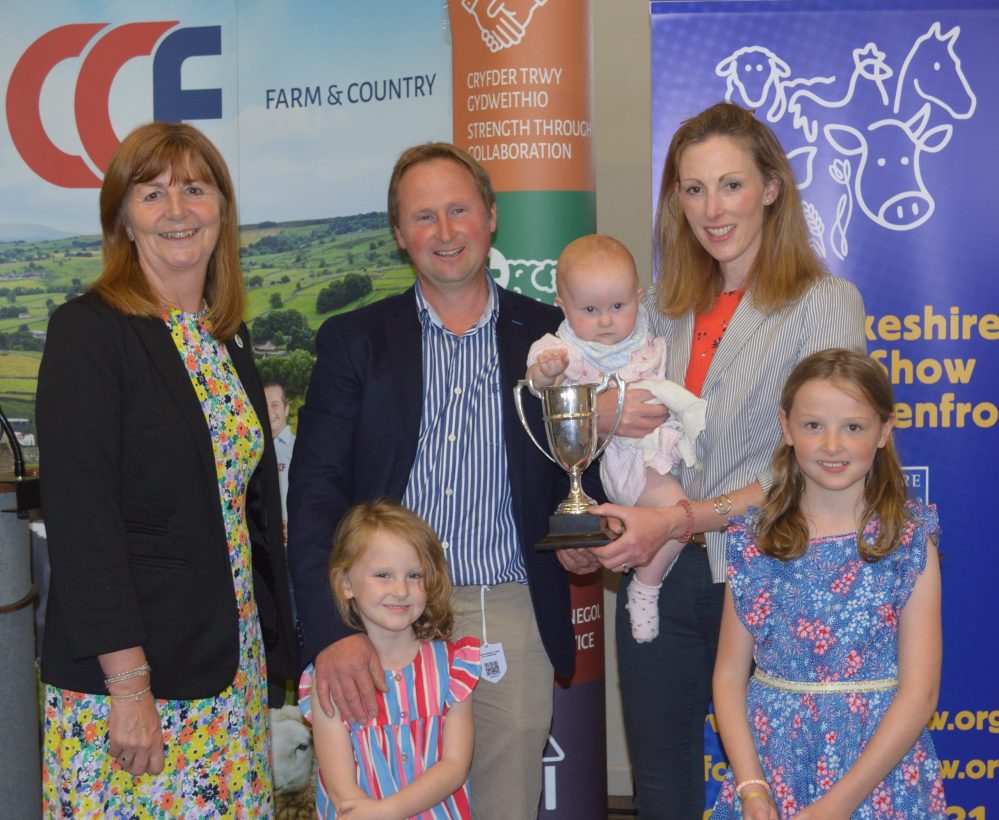
IF you farm in Pembrokeshire and can demonstrate your farm’s use of the latest technological methods to promote progressive, sustainable agriculture then the Pembrokeshire Agricultural Society encourage you to enter the prestigious Baron de Rutzen Award.
Adam Thorne, Pembrokeshire County Show President, said, “We are looking for local Pembrokeshire farmers, under the age of 45, who can demonstrate their farm’s use of the latest technological methods to promote progressive, sustainable agriculture. They also need to show consideration for the environment and habitat sensitivity on their farm as well as present an aesthetically pleasing example of farming in the county. The competition welcomes all livestock and arable sectors to take part.”
Last year’s winners of the Award were Mark and Caroline Davies of Little Newcastle, Haverfordwest. They milk 230 pedigree Holsteins through a fully automated system. They rear their own replacements and also have a small beef enterprise. The farm is all grassland and they follow a strict reseeding and liming policy to optimise the yield from their multi-cut silage system. The couple place significant emphasis on animal health, husbandry and breeding to maximise the efficiency of their system.
Baron John Fredrick De Rutzen was President of Pembrokeshire Agricultural Society in 1936 and the Baron de Rutzen Trophy was produced in his memory. The third Baron served in the Welsh Guards and tragically died, aged 36, in 1944.
This year’s entrants must be fully practising farmers within the county of Pembrokeshire and were under the age of 45 years on 1 January 2024. Entries can either be by nomination or direct application online on the Pembrokeshire Agricultural Society website. Click here to apply: Baron de Rutzen Award | Pembrokeshire County Show | Pembs Agricultural Society (pembsshow.org)
The closing date for nominations and applications is at noon on Wednesday, 29 May 2024.
Farming
Pembrokeshire Agricultural Society elect new president
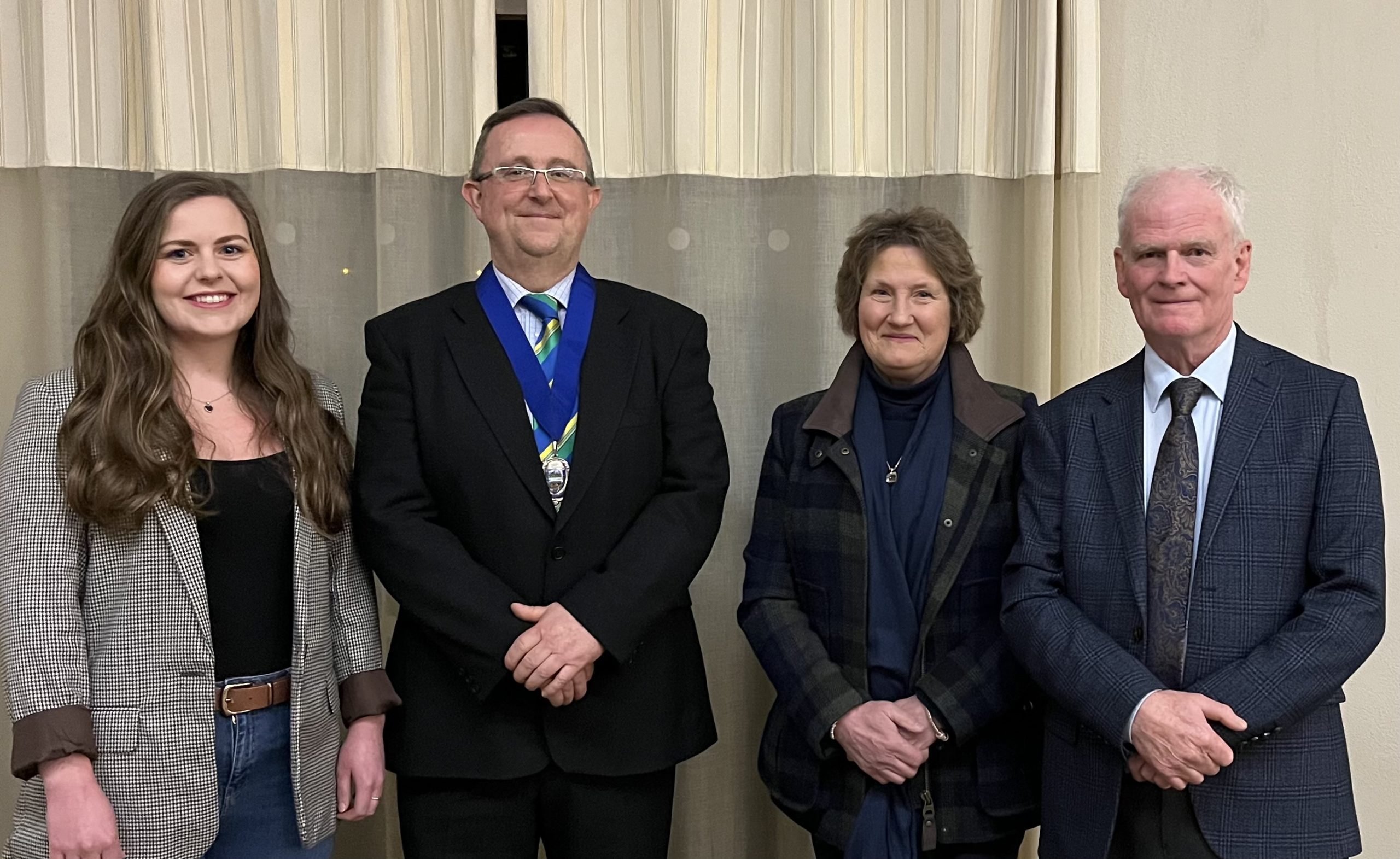
ARABLE and beef farmer, Adam Thorne, has been unanimously elected to become the new President of Pembrokeshire Agricultural Society for the year ahead. Adam is the third generation of his family to hold the position.
During the Annual General Meeting of Pembrokeshire Agricultural Society, held last week on the Pembrokeshire Showground, Mr Tim John and his wife Margaret John were also voted in as Presidents elect.
Adam Thorne has had a long association with Pembrokeshire Agricultural Society. After visiting the show as a toddler, then helping show the family’s pedigree Herefords, his uncle got him into helping him with stewarding in his early teens. From there he progressed to being a Steward with his own section, Commercial Cattle, and then also the Butcher’s Lambs section.
From stewarding, Adam became involved with committee work, starting as an Executive and then on to the former Finance and General Purposes Committee. He has been Chairman of the Estates Committee for 12 years and is now a Board member and a Trustee.
Adam said, “I am proud of my long association with Pembrokeshire Agricultural Society. I am the third generation to now be President, following my late grandfather, Walter Thorne, my father, Robert Thorne and more recently my uncle, George Thorne. I am looking forward to my year in the prestigious position.”
Away from his work with the society, Adam runs the family’s arable and beef farm in Robeston West, Milford Haven. He has been heavily involved with Tiers Cross YFC from an early age, having been Club Secretary twice and Chairman. He has also sat on Pembrokeshire County YFC Committees and the Wales YFC Rural Affairs Committee.
The 2024 Pembrokeshire Agricultural Society officeholders, announced at the AGM, include Miss Ffion Edwards who was awarded the role of Ambassador at last year’s show. Ffion, a nurse from Maenclochog, has enjoyed many years of attending the county show and believes that there are so many good elements to it. Ffion has been a member of Llysyfran YFC for 15 years and enjoys every aspect of young farmers – trying new experiences, competing and travelling to name a few. Mrs Nicola Owen was also elected as the Honorary Treasurer.
Brian Jones, the outgoing Pembrokeshire Agricultural Society President, took the opportunity to thank everyone who had helped and supported him throughout his presidency. During his year as President, Brian and his wife Helen, raised a tremendous amount of money for various charities including the Pembrokeshire Agricultural Society, RABI, Tir Dewi and the DPJ Foundation. Brian also gave his assurances that Castell Howell will continue to sponsor the Food Hall for future years.
Pembrokeshire County Show, the largest county agricultural show in Wales, will be held over two days again this summer on 14 and 15 August. Everyone is invited to attend the celebration of rural life in the county.
Pictured (left to right): Ffion Edwards the Ambassador for 2024; Adam Thorne, President; Margaret and Tim John, the Presidents Elect.
Farming
£1,000 bursary award available to Pembrokeshire agricultural students

PEMBROKESHIRE Agricultural Society’s £1,000 Bursary Award is now open for applications from students studying agriculture, veterinary science, agricultural engineering, food technology, forestry or other subjects allied to agriculture.
The Student Bursary Award 2024 is available to students, from Pembrokeshire, who are currently studying or have been accepted to start their studies. They can apply for this financial support to assist with their chosen college or career path.
Last year’s winner of the award was Lottie Wilson from Hayscastle. Lottie was studying agriculture at the University of Nottingham when she applied for the bursary. When she is at home she is a general dairy farm worker as well as a lambing hand and a calving beef herd assistant. In 2021 she was the top agriculture student at Hartpury College.
Robert James, Chairman of the Society’s Bursary Committee said, “I would urge all Pembrokeshire students who study subjects that are clearly aligned to agriculture to apply for this bursary as it won’t only assist with your studies but will also give you great experiences such as undertaking an interview which is a key employment skill. It will also assist in your future career within the agriculture industry.”
“A panel of independent judges will draw up a short list of candidates who will be interviewed and the winning candidate will be asked to give a short presentation at a future meeting of the society’s show council.
“The standard of applications has always been exceptional which gives a lot of heart that there are a lot of very talented young people in our community. We are very much looking forward to receiving applications for this year’s bursary and hearing from the younger generation.”
Qualifying students must not have won the student bursary on a previous occasion, the applicant must be studying or has been accepted to study agriculture or allied subjects at a UK college or university at A-Level or higher and the applicant’s family home must be in Pembrokeshire.
The bursary is tax free and will be awarded to the student who, in the opinion of the panel of judges, has submitted the best dissertation on how the bursary will assist them to complete their course of study.
Further details and the entry form can be found online: Student Bursary Award | Pembrokeshire County Show | Pembs Agricultural Society (pembsshow.org) or by calling the show office: 01437 764331. The closing date for applications is noon on Monday, 1 July 2024.
-
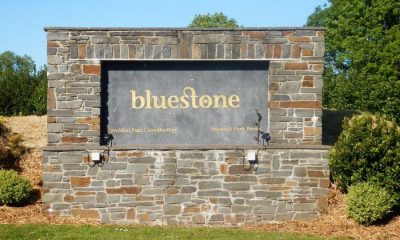
 Business4 days ago
Business4 days agoBluestone National Park Resort payments expected to end
-

 Community5 days ago
Community5 days agoThe Harbourmaster: Special rail excursion draws crowds to Milford Haven
-
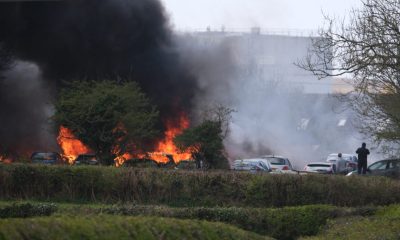
 News4 days ago
News4 days agoDragon LNG ‘monitoring’ scrap car blaze in Waterston
-
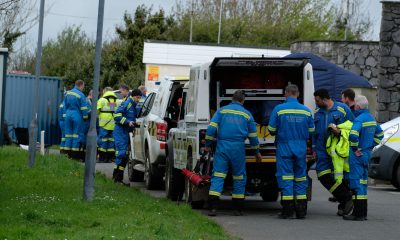
 News5 days ago
News5 days agoSearch for Luke, 19, reported missing in the Pembroke Dock area, continuing
-
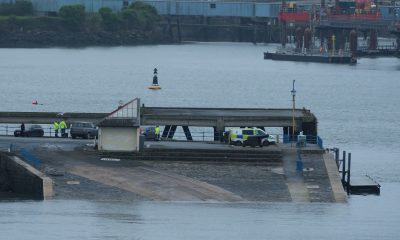
 News2 days ago
News2 days agoSearch for missing teenager Luke continues at Pembroke Dock
-

 Crime3 days ago
Crime3 days agoEstate agents admit health and safety failings following fatal market incident
-

 News7 days ago
News7 days agoMajor search in the area of The Cleddau Bridge and Hobbs Point
-
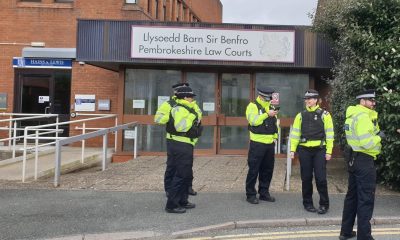
 News3 days ago
News3 days agoMan jailed after scarring police officer in Narberth altercation
















